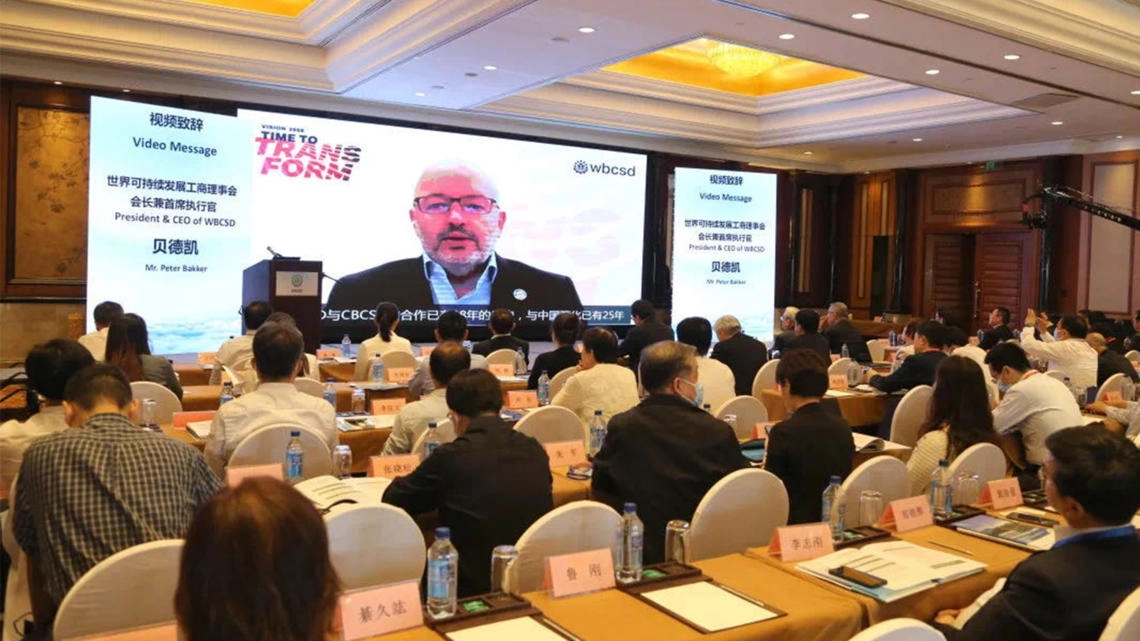Beijing, China, 27 May 2021: The World Business Council for Sustainable Development (WBCSD) launched the Chinese version of Vision 2050: Time to Transform at the 17th Conference on Latest Trends of Sustainable Development, organized jointly with the China Business Council for Sustainable Development (CBCSD). The conference focused on business and sustainability under China’s 14th Five-Year Plan and the Government’s Vision 2035 planning.
In his video message to the conference, WBCSD President and CEO Peter Bakker emphasized the private sector’s critical role, in China and around the world, in transitioning towards a world in which 9+ billion people can live well, within planetary boundaries, for instance by becoming nature positive and achieving net zero emissions. China is accelerating its sustainability actions, and the country’s September 2020 climate commitments marked a historic precedent. Furthermore, China’s 14th Five-Year Plan includes focus on the energy transition, new types of sustainable urban development and green investment priorities. Bakker added that China will also play a critical role in linking biodiversity and climate through its hosting of CBD COP15 in Kunming this October.
Vision 2050: Time to Transform is the result of two years of work by WBCSD and more than 40 of its members, all major global companies, and the Chinese version was developed with the help of CBCSD, WBCSD’s Global Network partner in China. Vision 2050: Time to Transform lays out a new framework to guide business action in the decade ahead. At the heart of this framework are nine transformation pathways covering the areas of business activity that are essential to society: energy; transportation and mobility; living spaces; products and materials; financial products and services; connectivity; health and wellbeing; water and sanitation; and food. The vision and transformation pathways are aligned with the Sustainable Development Goals (SDGs) and the targets of the Paris Agreement.
“The concept of systems transformation is crucial. In Vision 2050: Time to Transform, we focus on nine pathways of systems transformation, written in an actionable format for business leaders around the world. It should influence the strategic business agenda for this decade”, added WBCSD President and CEO Peter Bakker. “In China and around the world, business has to play a leading role in the transformations toward our common vision for carbon neutrality, working together with governments, regulators, investors and all people.”
Additionally, Peter Bakker highlighted the LEEP-China project, developed through the joint WBCSD-CBCSD platform, which offers an opportunity for companies to help shape the vision of the Chinese government for a new sustainable urban development in the Xiong’an New Area.
Other remarks came from Mr Zhu Hongren, Standing Vice President and Director-General of China Enterprise Confederation (CEC); Mr. Peng Huagang, Secretary-General of the State-owned Assets Supervision and Administration Commission of the State Council (SASAC) and Member of the Party Committee; Mr Li Haisheng, Director of the Chinese Research Academy of Environmental Sciences; and Mr Wang Zhongying, Director and Researcher of Energy Research Institute (ERI), National Development and Reform Commission (NDRC). Wang Jiming, President of CBCSD and Academician of the CAE, delivered the closing remarks, expressing the hope that businesses could overcome difficulties and challenges in the next decade, understand the development opportunities highlighted in the latest trends, and integrate sustainable development into long-term corporate strategies.
For more information about Vision 2050: Time to Transform, please visit our dedicated website.
The report is available in:
For more information on our work in China, please contact Wei Dong Zhou, Director of WBCSD’s China Office.
For more information on Vision 2050, please contact Julian Hill-Landolt, Director, Vision 2050.
WBCSD news articles and insights may be republished in accordance with the Creative Commons Attribution-NonCommercial-NoDerivatives 4.0 International Public License, and in accordance with our Privacy Policy. All Content must be featured with due credits.

